TL;DR: We chose the Icebreaker Mountaineer Heavy socks as the best winter hiking socks to keep your feet warm on cold, wintry trails. Our key reasons for choosing them are:
- The top-notch quality of the wool
- Overall durability
With so many companies selling hiking socks, it’s challenging to differentiate between them all. Everyone says theirs is the best, but can you trust them?
Keeping your feet warm in winter is vital, whether you’re hiking outdoors or at home. Your feet are crucial to keeping the rest of your body warm.
When I first started hiking, I didn’t think having a good pair of socks was that important. I started out wearing my Vans knee-high socks, but I soon learned this was a bad idea.
It wasn’t until I wore my first pair of proper hiking socks that I realized how important they were. I couldn’t improve my hikes while my feet were frozen or blistered. It was impossible.
I’ve tried many different pairs of socks throughout the years, and I currently have a rotation of a few that I love.
A good pair of hiking socks is a game-changer for combatting cold feet and blisters.
If you want to take the guessing games out of finding the perfect hiking sock, keep reading my guide to finding the best winter hiking socks!
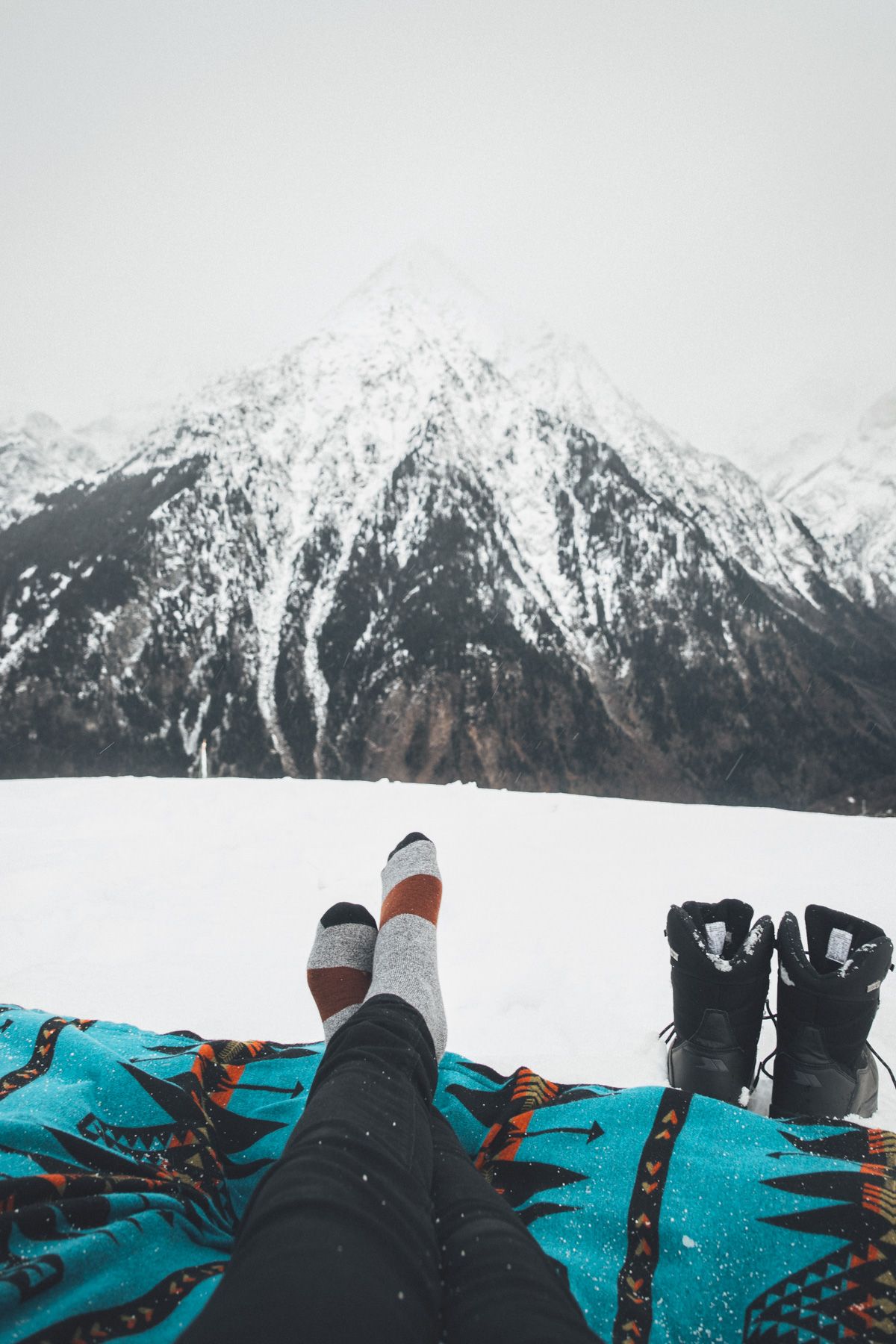
#1 Darn Tough Mountaineering Socks
Best Merino Winter Hiking Sock
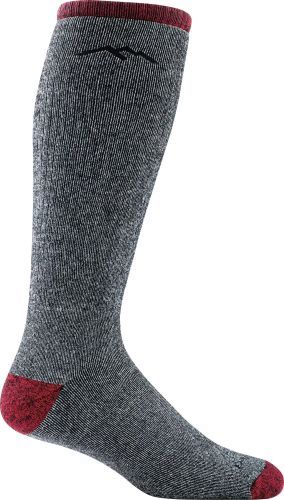
Material: 72% Merino wool, 26% nylon, 2% spandex
Length: Knee-high
When I find something I like, I generally go back to it again and again. Take, for example, the Darn Tough Mountaineering Socks. Once I discovered these Darn Tough Socks, I became a loyal customer.
Merino wool has a reputation amongst the hiking community as one of the best materials to keep you warm on the trail.
Some brands of Merino wool socks can feel heavy and somewhat uncomfortable. But that’s not the case for Darn Tough!
Darn Tough Mountaineering Merino wool hiking socks use a mixture of materials to help increase durability and ensure you get what you pay for.
Even though I buy multiple pairs of hiking socks at once, I still prefer them to last a long time.
Hiking socks need to be moisture-wicking, and Darn Tough delivers on that front. Darn Tough hiker socks are moisture-wicking, which ensures I don’t have to worry about the moisture getting trapped, which will make my feet feel wet.
These Darn Tough full cushion mountaineering socks have extra cushioning for fewer blisters and will make you feel amazing on the trail.
I suggest looking into the Darn Tough Quarter Cushion if you also want a good sock for summer hiking and warmer weather. This cushion isn’t as thick, so it won’t have you sweating as much.
Darn Tough Merino wool socks are pricier than competitors, but I promise they’re worth it! Pair these with waterproof boots, and you have yourself a lethal combo.
While these socks aren’t pure wool, the synthetic materials will help them last longer.
PROS
- Are moisture wicking
- 26% nylon for increased durability
- Extreme comfort feeling
CONS
- Pricey when compared to others on the market
#2 Thorlos St Max
Most Comfortable Winter Hiking Sock
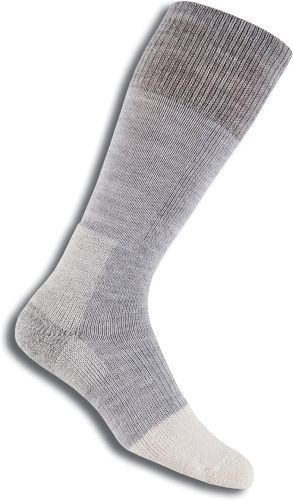
Material: 60% worsted wool, 27% THORLON acrylic, 11% nylon, 2% spandex
Length: Over the Calf
Everyone likes to be comfortable, especially during a long hike during winter. If comfort is your top priority, the Thorlos St Max socks are a perfect match for you!
The Thorlos socks use a priority material that they call Thorlon acrylic. This fabric provides a specific type of padding for extra cushion to keep your feet comfortable.
In addition to Thorlon, these socks use blends of yarn that keep the moisture out and your feet dry throughout your hike.
These Thorlos socks aren’t the most stylish hiking socks, but that’s not the point. They get the job done better than 99% of other hiking socks on the market, and you’ll be ready for the hiking trails.
While Thorlos St Max socks are best for a winter hike, the brand has other styles if you prefer a thinner sock.
Thorlos St Max socks come up over the calf, which I prefer if I’m going on a colder-than-usual hike because they’ll ensure I stay warm throughout.
PROS
- Made with unique fabric to keep you extra comfortable
- Has padding inside the sock
- Great for winter hikes
CONS
- Aren’t super stylish
#3 Smartwool Mountaineer Socks
Best Value
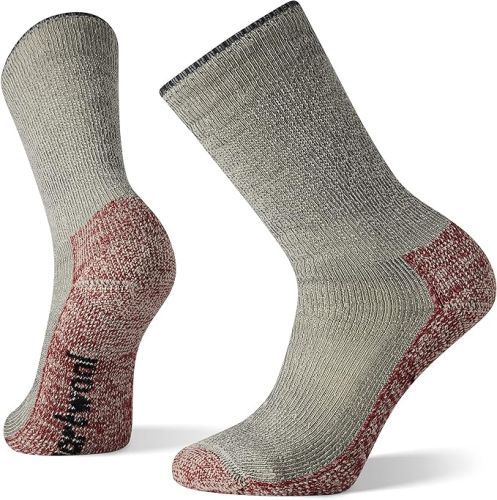
Material: 74% Merino Wool/8% Nylon/17% Recycled Nylon/1% Elastane
Length: Below the Calf
Sometimes, when I’m shopping, I look for the best deals on the market. Winter socks can be pricey, which made my bargain-hunting difficult. That was until I found the Smartwool Mountaineer socks.
The Smartwool Mountaineer cold weather sock is just as good as other Merino socks but at a better price. It’s Smartwool’s thickest and warmest sock, undoubtedly to keep you warm on your hiking or backpacking trip.
Like other hiking socks, the Smartwool Performance hike socks use synthetic materials, like nylon, to increase durability. All of these blended synthetics come from recycled material!
Normal socks, such as cotton socks, will get your feet wet and keep them wet. Even though this style is one of Smartwool’s warmest socks, you can rest assured that they will wick moisture and keep your feet dry.
This pair of synthetic socks isn’t over-the-calf style, so if you want something longer, the Smartwool socks might not suit you.
An honorable mention would be REI’s Midweight sock. I currently own a pair of these, and I love them because they get the job done at less than $20!
PROS
- Made from recycled materials
- Extremely durable
- Affordable Price
CONS
- It doesn’t come in an over-the-calf version
CHECK PRICE ON:
#4 Minus33
Most Durable Winter Hiking Sock
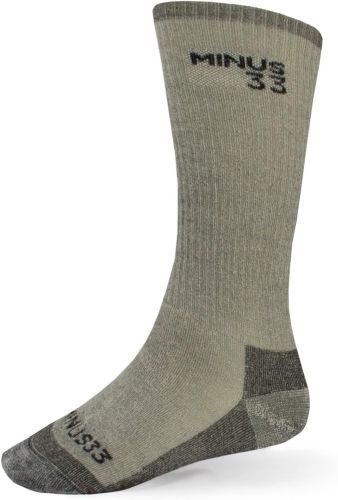
Material: 82% Merino Wool, 10% Polyester, 5% Nylon, 3% Spandex
Length: Mid Calf
If you’re an avid hiker like me, socks can wear down quickly. I always look for the most durable socks and have found that I love Minus33!
Most hiking socks you’ll be looking at will also be Merino socks. This material helps keep your feet warm while removing any moisture. What separates Minus33 from other socks are the other materials in the blend.
Minus33 uses less nylon than other brands and adds polyester, which helps lower the price. Using Spandex helps stretch the sock and, in return, makes it more durable.
Moreover, even though there’s a combination of different synthetic materials, the Minus33 still has one of the highest percentages of Merino wool on this list.
I love the Minus33 brand because I trust their products, which have existed since 2004. These socks don’t come in many colors or variations, but you’ll know you’re getting a quality product when purchasing.
Minus33 offers a full-length sock that will easily fit any size foot. While some might consider these thick socks, they’re thinner than others on this list.
Minus33 socks will help you stay warm, dry, and comfortable without feeling weighed down by a thick, heavy pair of socks.
PROS
- It uses a mixture of Nylon and Polyester to keep the cost low
- Spandex to help stretch the sock for any fit and increase durability
- A trust-worthy brand since 2004
- It uses multiple types of synthetic materials
CONS
- It doesn’t come in many colors or styles
CHECK PRICE ON:
#5 Farm to Feet Max Patch
Best Anti-blister Winter Hiking Sock
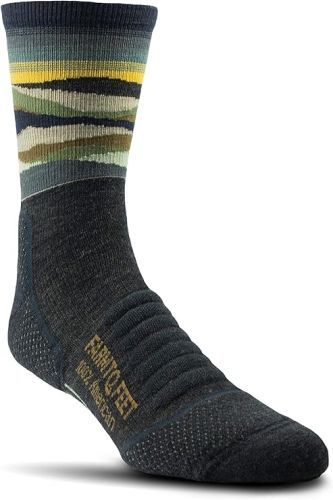
Material: 49% Nylon, 47% Merino Wool, 4% Lycra Spandex
Length: Mid Calf
During my early hiking career, I was nervous I’d get huge blisters from hiking long distances. If you’re feeling a little nervous about blisters, too, check out the Farm to Feet socks.
What makes the Farm to Feet socks so great is their approach to padding. They place padding where it matters, which helps reduce the impact of hiking on your feet.
Hiking boots can become painful after hours of hiking, and you need more than just a regular synthetic sock. Thicker socks can help, but that isn’t always the correct approach.
Your toes are a common area where you can get blisters on your foot when hiking. Farm to Feet socks knit their sock in a specific way to create a flat connection in the toe box.
This flat connection removes the friction that causes the blisters. The downside to the Farm to Feet socks is that they contain less Merino wool than the other socks on this list, such as Darn Tough and Icebreaker.
That lack of wool might be alright for some people because more nylon makes these socks more durable. But less Merino wool will make it more difficult to stay dry.
PROS
- Specially placed padded sections
- Flat connection in the toes to reduce blisters
- More nylon to help increase durability
CONS
- Less Merino wool
#6 Icebreaker Mountaineer Heavy
Best Liner
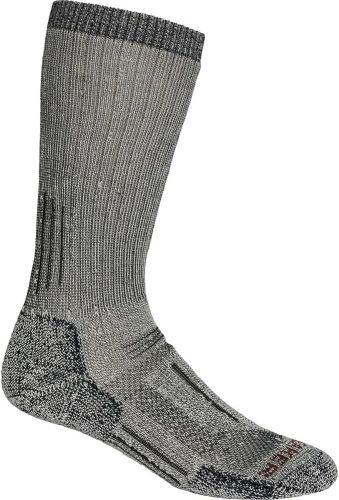
Material: 80% Merino Wool, 19% Nylon, 1% LYCRA®
Length: Mid Calf
Socks should be comfortable, and that’s no different than hiking socks. I love the Icebreaker Merino wool socks, which have the best liner and fine microfiber design!
Not only are the Icebreaker socks great for cold weather, but they’ll also feel like silk on your feet. The silkiness is primarily due to the size of their Merino wool fiber.
The smaller the micron, the smoother the feel. Icebreaker’s micron is almost half the size of other synthetic socks. Icebreakers are so soft you’ll forget you have hiking shoes on!
These hiking socks are also 80% Merino wool, so they quickly wick moisture out. Moisture-wicking capabilities are essential for hiking socks and are a compelling factor in choosing Merino wool socks over cotton socks.
While the Icebreaker hiking socks are slightly more expensive than others on this list, they are well worth the extra money.
Socks are a non-negotiable staple for all your backpacking trips, and the Icebreaker Mountaineer Heavy socks won’t let you down.
What’s not to love about a comfortable yet highly effective hiking sock?
If you want waterproof socks that feel like a cozy Christmas morning, then the Icebreaker Mountaineer Heavy is for you.
PROS
- Smaller Merino microns for a smoother feel
- Made from 80% Merino wool
- Long-lasting
CONS
- On the expensive side compared to other hiking socks on this list
#7 Wigwam Men’s 40 Below
Warmest Winter Hiking Sock
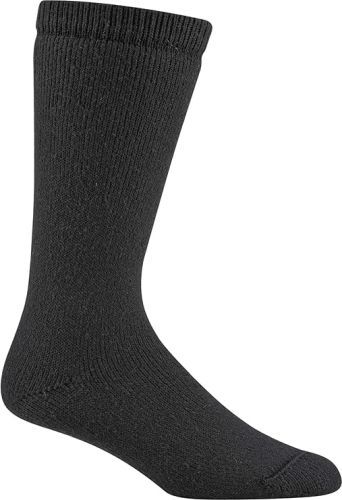
Material: 51% Nylon, 49% Wool
Length: Mid Calf
If you love the snow or are simply looking for a good skiing sock, you’ll want one of the best winter hiking socks to keep you warm. That’s precisely what Wigwam 40 Below is.
The Wigwam socks are fully cushioned throughout, creating the same feeling as having a tight blanket around your foot. Amazing right? All other winter socks should take note.
Winter hiking socks like the Wigwam have some nylon mixed with Merino wool. There’s 51% Nylon in these socks, creating a durable sock that will last years.
Don’t worry; there’s still enough Merino wool not to turn these winter hiking socks into wet socks. Wigwam 40 Below Socks aren’t fancy, but that’s not why you’d want to buy these.
Ensuring you have the right hiking gear for all situations is critical to a successful hike. When your socks perform how you want them to on the trail, that’s one less thing to worry about.
Wigwam socks execute at the highest level, but you don’t have to be afraid when they rip or tear because of their lifetime warranty.
Having the warmest socks for winter is something we should always have in our arsenal. Wigwam winter hiking socks have a lifetime warranty, so you know you’ll be set for life!
PROS
- Fully cushioned socks for extra comfort
- Made from 51% Nylon fabric for increased durability
- Lifetime warranty
CONS
- It doesn’t have any flashy designs
Buying Guide: How to Choose the Best [product] and What to Look For
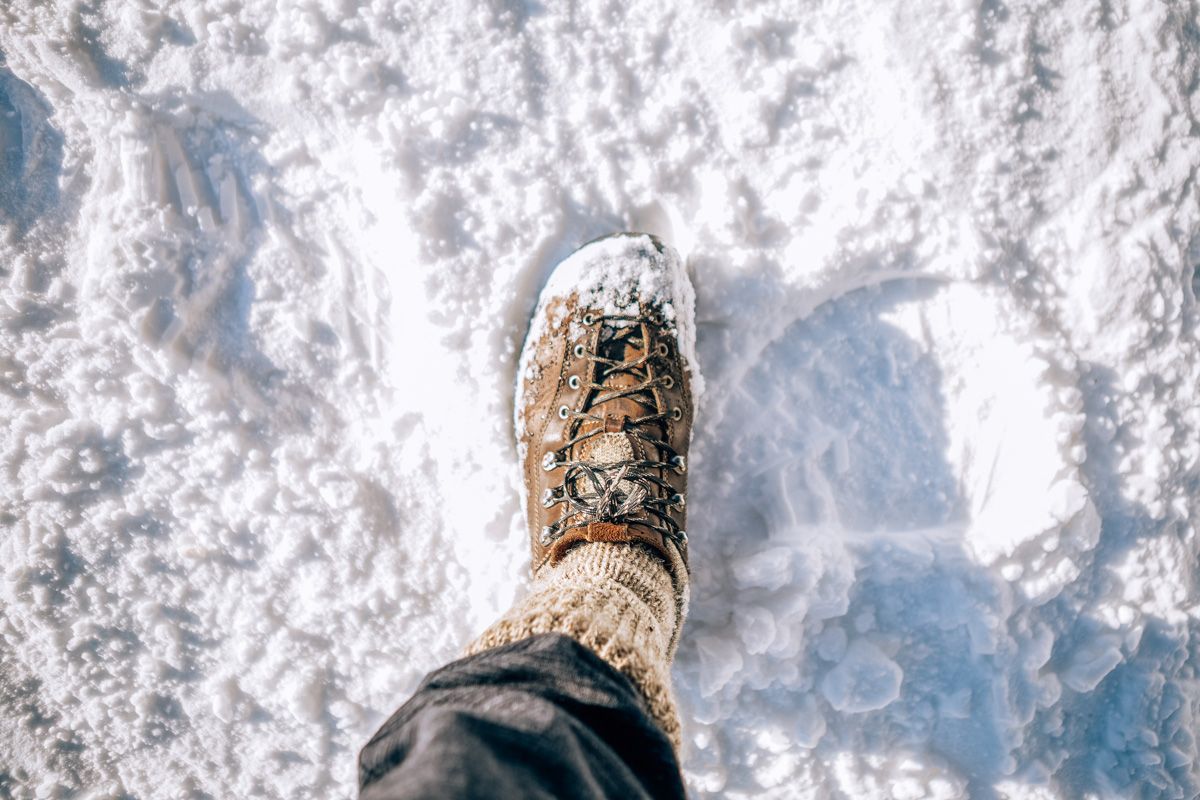
Warmth
Finding the perfect winter hiking socks can be challenging, but one critical thing to always look for is warmth.
The best winter hiking socks keep you warm, but pairing your activity with the right sock is critical.
Choosing mountaineering socks, which are thicker and go up higher, might not be ideal if you’re hiking during the summer. In contrast, having a thicker sock if you plan a mountain trip will help.
I like to bring multiple pairs/style socks when hiking and backpacking. I always try to avoid cotton socks as they aren’t ideal for a hiking environment and can lead to hypothermia if they get wet.
All the socks on this list are designed to keep your toes warm in the winter. Darn Tough is one example of a company that makes ultra-warm socks with a range of different varieties available.
Moisture-Wicking
You might be wondering what moisture-wicking means. When I first started shopping for winter hiking socks, I was a little confused, too.
Let me clear that up for you: certain materials can pull moisture away from your body, allowing it to evaporate quickly. We call that process ‘moisture-wicking.’
Merino wool has natural moisture-wicking properties, making it a popular material for winter hiking socks.
Some other valuable qualities of Merino wool are odor-resistance temperature regulation. On top of all that, Merino wool is a sustainable and renewable resource.
Many winter hiking sock companies mix Merino wool with other fabrics to increase durability while maintaining moisture-wicking ability. More on the different fabrics later!
Thickness/Cushioning
Choosing winter hiking socks with the right thickness and cushioning can make or break your experience on the trail.
Just like you’d choose thick hiking pants to match the cold weather you’ll be hiking in; you should also do the same when you choose your socks.
What’s more, extra cushioning for your foot will help increase the comfort of your sock. Thinner socks often lead to blisters, which can de-rail any hike.
One sock that does an excellent job of this is Wigwam’s Below 40. The inner layer has extra cushioning for that increased comfort feeling.
A high-cushion sock will keep your toes warm and the rest of yourself happy. Stay away from cotton socks if you don’t want cold feet, especially if you plan on hiking in cold weather.
Even the best hiking socks can sometimes fall short in challenging conditions. Add sock liners if you think your socks won’t keep you warm enough.
A liner is an inner layer under your hiking socks that adds extra warmth without the bulky feeling of wearing two pairs. I always travel with an additional inner layer if the temperature is slightly colder than anticipated.
Length
As with all outdoor gear, you should choose the length of your hiking socks depending on the activity.
Generally, shorter socks will do the trick when hiking in summer or spring. But the same socks you wore in warmer months might not cut it for winter hiking.
Over the Calf: You’ll want over-the-calf wool socks in colder weather. This length is the best at keeping you warm in freezing temperatures.
One drawback of this style is that it doesn’t make for a lightweight sock, so they might not suit you if you’re not hiking in frigid temperatures.
Below the Calf: Medium-height hiking socks are perfect for a cold winter day (with the right pants) but are versatile enough to wear on warmer ones. This is the best all-around length for cold-weather wool socks in moderate winter climates.
Low Cut: Short wool hiking socks function best as summer hiking socks. I have a pair of low-cut Darn Tough socks that I love but would never bring when going mountaineering.
So, choose the correct sock style to keep your feet warm during a cold-weather hike.
Comfort
Comfort is everyone’s goal when hiking. It’s important! A blister is one of the most uncomfortable things that can happen during a hike.
Proper hiking shoes and wool hiking socks will help with blister prevention. Wool keeps your feet warm and dry, drastically increasing your comfort level.
The Farm to Feet Merino wool hiking socks are the best socks to prevent blisters.
What makes these socks so unique is their design. These socks feature specially placed padded sections to reduce friction in high-friction spots. On top of this, they have a flat connection in the toe box region, significantly reducing blisters.
If reducing blisters while hiking is your primary concern, these are some qualities to look out for.
Durability
Even though your socks might be one of the cheapest items you’ll purchase for your backpacking trip, it’s still essential for them to be durable.
While Merino wool is a popular material for hiking socks, many of the hiking socks you’ll come across will be a mixture of different fabrics.
But blending other materials like nylon, polyester, or spandex increases the durability of wool socks.
Nylon is the strongest but typically costs the most. Polyester is a cheaper alternative to nylon but still holds up quite firmly.
Spandex works excellently to increase stretchiness and prevent your socks from tearing, which is essential if you get over-the-calf hiking socks.
So, depending on your values and the type of sock you’re looking for, consider the percentage of each material in your socks.
For a good breakdown of the differences between wool and synthetic materials (plus some more options for Darn Tough socks!), check out this video:
FAQs About Winter Hiking Socks
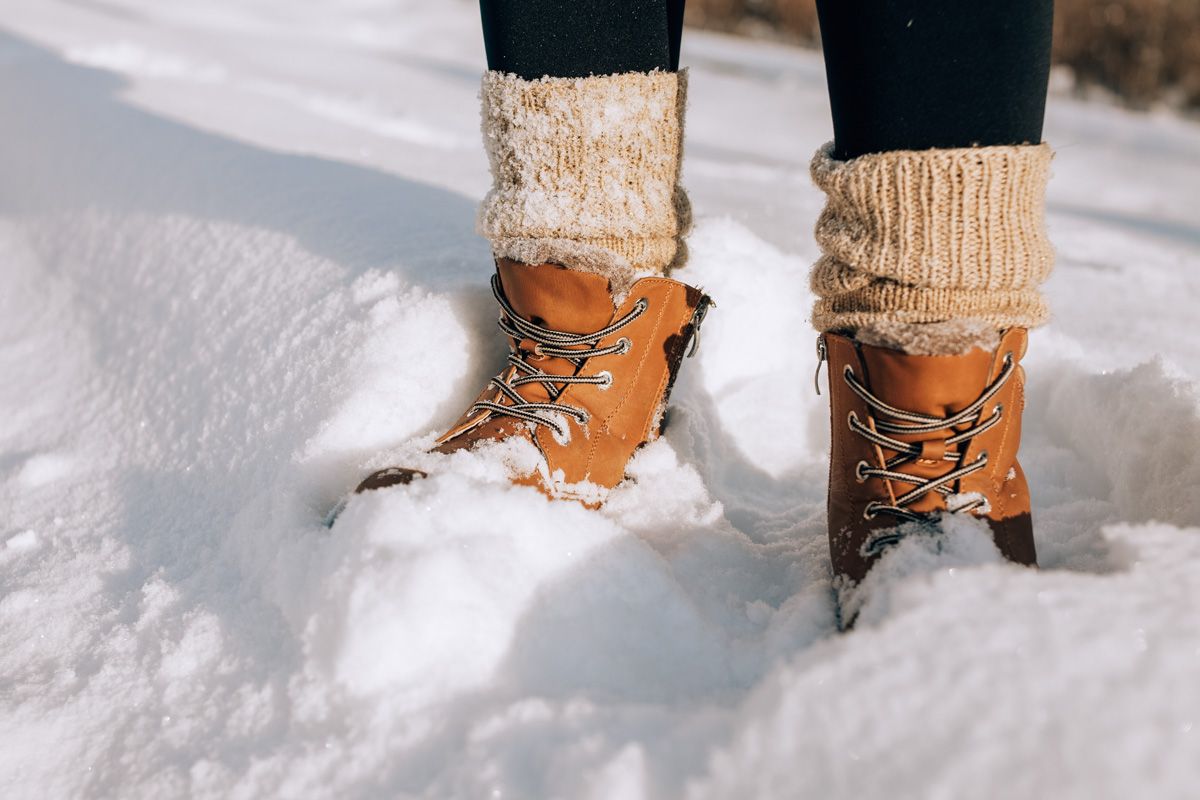
What material is best for winter hiking socks?
Merino wool is the most popular fabric and is a must when picking a hiking sock. But most winter hiking socks aren’t pure wool. Typically, these socks use a combination of different fabrics.
Other synthetic fibers, like nylon and polyester, are crucial for the best sock performance. When choosing the best winter hiking socks, consider which synthetic materials they contain.
If you want your socks to be as durable as possible, you’ll have to ensure there’s a percentage of nylon fabric in them. The more there is, the more durable they’ll be.
It’s also important to look at the wool’s micron size. Heavyweight socks will have larger microns, and you can feel the difference. The smaller the micron of wool, the smoother the feel.
What’s special about Smartwool socks?
Smartwool is one of the most popular outdoor sock brands. You can wear their snug-fit socks on the ski slopes or the hiking trails.
What’s so special about Smartwool? They pioneered the use of the now-standard Merino wool in their socks.
To this day, Smartwool prides itself on being one of the most sustainable sock companies on the planet.
So, if you value a quality product with excellent sustainability practices, look no further than Smartwool.
What’s the difference between hiking socks and regular socks?
Hiking socks are built for the wear and tear of the outdoors, whereas regular socks aren’t.
Regular socks are often cotton, which might feel comfortable but don’t help you perform on a hike. When cotton gets wet, it stays moist. That’s because cotton can’t wick moisture like wool can.
Getting a blister while backpacking can derail the entire trip, but wool hiking socks are also anti-blister socks due to their cushioned sections and the material’s inherent qualities.
Some hikers love toe socks, but they can have durability issues. What creates a more durable sock is the use of fabrics such as nylon and polyester.
Synthetic materials like nylon increase the price slightly but make a long-lasting hiking sock you’ll have complete trust in.
Are wool socks good for winter hiking?
Wool socks are suitable for more than just winter hiking but are the preferred fabric in hiking socks!
Merino wool is sustainable and hiking-friendly, making it the most common type of wool for hiking socks.
Having wet socks is a miserable experience; I know firsthand. Merino wool helps to wick that moisture out so it can evaporate fast. While fully waterproof socks don’t exist, Merino wool socks are as close as you can get.
Other benefits of wool for winter hiking are less blisters and more warmth. Keeping your feet (and hands) warm drastically improves overall body warmth.
Compression socks can be beneficial, but I don’t recommend them over wool socks for hiking. The main reason to wear compression socks is their potential to help with soreness.
Do two layers of socks keep your feet warmer?
I recently had to use two layers of socks when climbing Huyani Potosi, a mountain in Bolivia. Two layers of socks will help to keep your feet warmer.
I, unfortunately, made the mistake of only bringing one pair of hiking socks, and my second layer was a cotton-based sock.
Using one cotton and one wool helped a lot, but it would have been wiser to have two layers of wool socks instead of just one.
Will winter socks make my feet sweaty?
Generally, a good winter sock will make your feet less sweaty–or at least make them appear that way. Everyone is different, though; some sweat a little more with wool.
Just because you might sweat more in wool than cotton socks doesn’t mean your feet will be more wet. The Merino wool will wick moisture out and keep your feet dryer.
If you still find that wool socks make your feet sweatier, I suggest double-checking your socks’ exact material.
Some socks might use other types of wool than Merino or such a high percentage of synthetics that Merino’s benefits get lost.
However, that won’t be an issue if you choose from one of the socks on this list!
Do I need thick socks for winter hiking?
You need thick socks for winter hiking, but the optimal thickness depends on many factors.
Extra cushion will lower the chances of getting a blister from your hiking boots. If you plan on hiking in frigid weather, choose a thicker sock.
When hiking in cooler climates, an extremely thick sock will make you sweat more and won’t be that beneficial.
Though your socks will most likely contain Merino wool, it’s a good idea to cut the sweating down as much as possible by paying attention to your socks’ thickness.
If you plan on doing a mountaineering expedition, you might have to double up on socks as I once did.
Conclusion: Our Pick for the Best Winter Hiking Socks
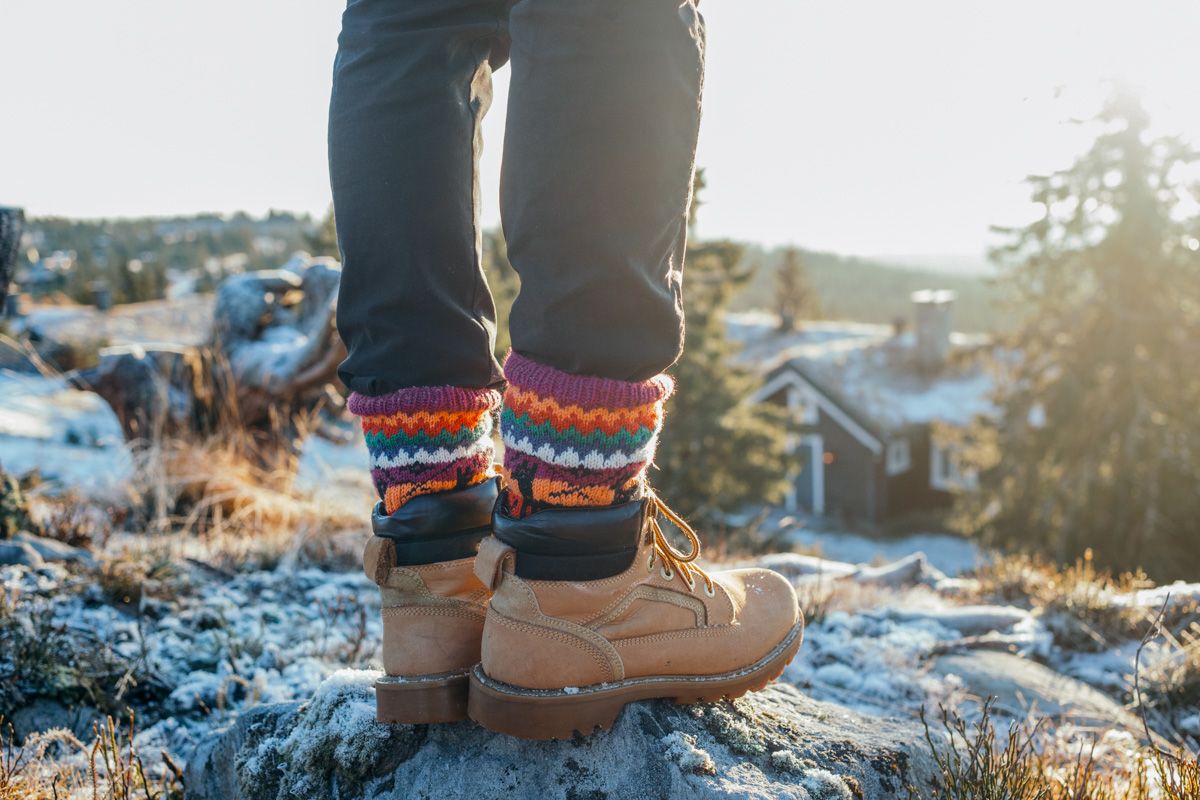
When picking the best winter hiking sock for hiking, I’d choose the Icebreaker Mountain Heavy over them all!
The Icebreaker sock is a beast when it comes to durability and warmth, but it’s also comfortable, too! Icebreakers reach mid-calf length, which makes them perfect for most winter situations.
What truly sets Icebreakers apart from others on this list is the fabric that they use. Of course, as is every sock on this list, they contain plenty of Merino wool, but they’re a thinner version.
The smaller the microns, the softer the sock, which thus provides a more enjoyable experience on the trail. Also, 80% of the fabric is Merino wool, so your sweat will wick away fast!
The rest of the material (19%) is nylon, which helps to create a more durable sock, so there are no issues with it lasting on many hikes to come.
So, if you’re looking for the best overall hiking socks for the winter, then look no further than the Icebreaker Mountain Heavy!
ABOUT THE AUTHOR

Phillip Anderson
Phillip Anderson is a freelance travel writer, personal trainer, and adventure enthusiast from Virginia Beach. Growing up, he spent most of his days either hiking in the Shenandoah, going to the beach, or working out. He is currently traveling through Latin America while working on projects to share his adventures with the world.
Shopping for hiking gear? Check out these related articles below!
Best Hiking Underwear for Women
Best Hiking Backpacks for Women
Best Dog Backpack Carriers for Hiking
Best Minimalist Hiking Sandals
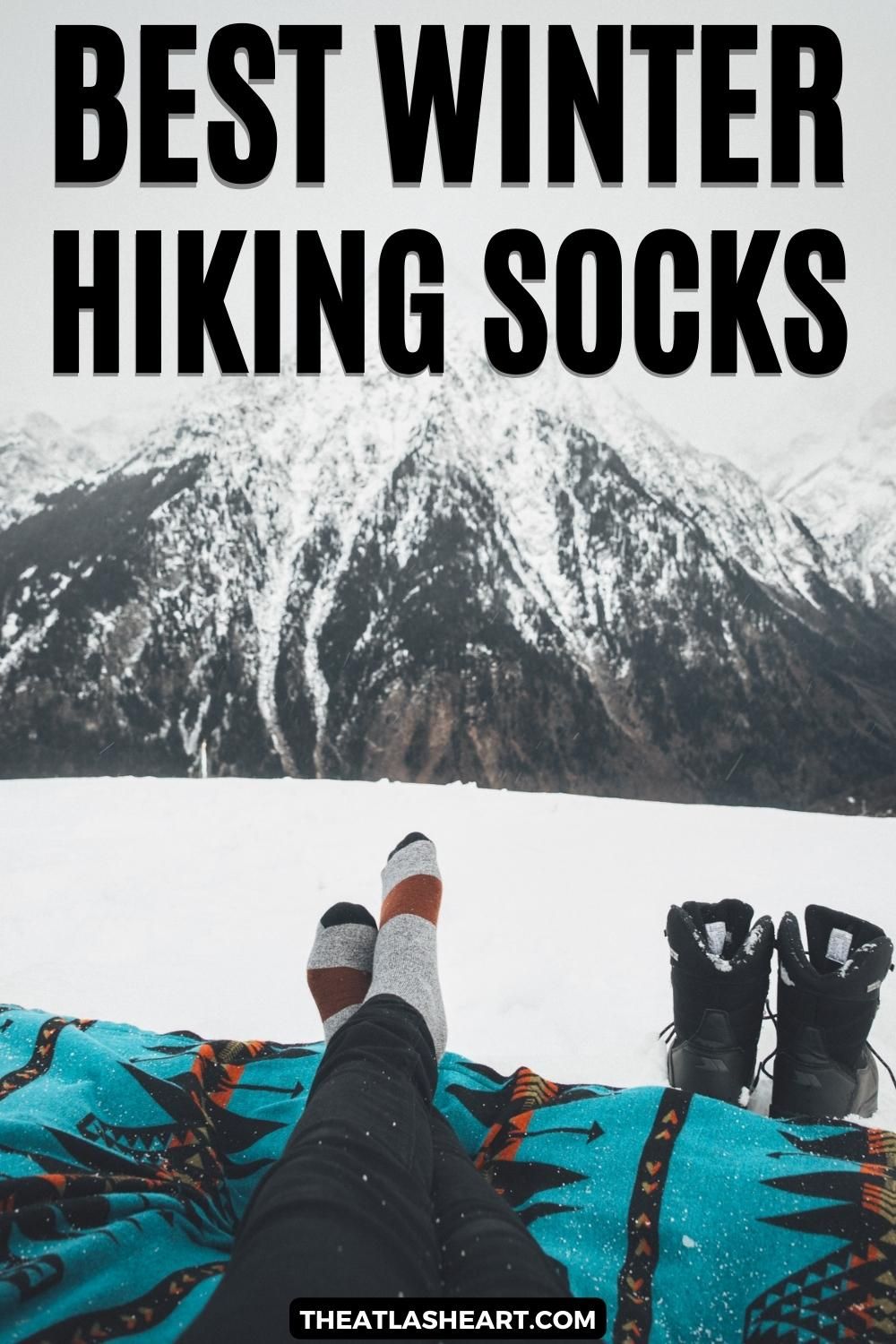
Pin this image for future reference


